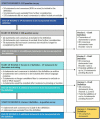Consensus Definition of Misophonia: A Delphi Study
- PMID: 35368272
- PMCID: PMC8969743
- DOI: 10.3389/fnins.2022.841816
Consensus Definition of Misophonia: A Delphi Study
Abstract
Misophonia is a disorder of decreased tolerance to specific sounds or their associated stimuli that has been characterized using different language and methodologies. The absence of a common understanding or foundational definition of misophonia hinders progress in research to understand the disorder and develop effective treatments for individuals suffering from misophonia. From June 2020 through January 2021, the authors conducted a study to determine whether a committee of experts with diverse expertise related to misophonia could develop a consensus definition of misophonia. An expert committee used a modified Delphi method to evaluate candidate definitional statements that were identified through a systematic review of the published literature. Over four rounds of iterative voting, revision, and exclusion, the committee made decisions to include, exclude, or revise these statements in the definition based on the currently available scientific and clinical evidence. A definitional statement was included in the final definition only after reaching consensus at 80% or more of the committee agreeing with its premise and phrasing. The results of this rigorous consensus-building process were compiled into a final definition of misophonia that is presented here. This definition will serve as an important step to bring cohesion to the growing field of researchers and clinicians who seek to better understand and support individuals experiencing misophonia.
Keywords: consensus building; emotional dysregulation; medical definitions; misophonia; misophonia triggers; sensory sensitivities; sound sensitivity (auditory sensitivity).
Copyright © 2022 Swedo, Baguley, Denys, Dixon, Erfanian, Fioretti, Jastreboff, Kumar, Rosenthal, Rouw, Schiller, Simner, Storch, Taylor, Werff, Altimus and Raver.
Conflict of interest statement
The authors declare that this study received funding from the REAM Foundation (grant number 7894 to the Milken Institute Center for Strategic Philanthropy). The funder was not involved in the study design, collection, analysis, interpretation of data, the writing of this article, or the decision to submit it for publication.
Figures


Comment in
-
Commentary: Consensus definition of misophonia.Front Neurosci. 2023 Jan 4;16:1077097. doi: 10.3389/fnins.2022.1077097. eCollection 2022. Front Neurosci. 2023. PMID: 36685217 Free PMC article. No abstract available.
References
-
- Baguley D. M., Cope T. E., McFerran D. (2016). “Functional Auditory Disorders,” in Handbook of Clinical Neurology, eds Hallet M., Stone J., Carson A. (Amsterdam: Elsevier; ), 367–378. - PubMed
-
- Bernstein R. E., Angell K. L., Dehle C. M. (2013). A brief course of cognitive behavioural therapy for the treatment of misophonia: a case example. Cogn. Behav. Ther. 6:e10. 10.1017/S1754470X13000172 - DOI
LinkOut - more resources
Full Text Sources
Medical

